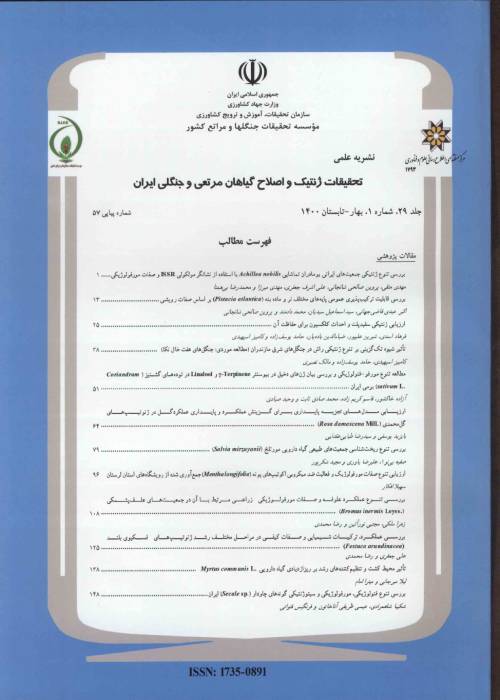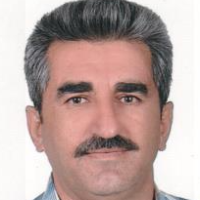Evaluation of genetic and biochemical variation in six basil (Ocimum basilicum L.) populations
Author(s):
Article Type:
Research/Original Article (دارای رتبه معتبر)
Abstract:
The success of plant breeders depends on the genetic diversity amount in plants and their wild relatives. Awareness of genetic distance and similarity makes it possible to organize hereditary reserves, effective sampling of genotypes, and better use of diversity. This research was carried out to study the genetic diversity of six basil populations (Ocimum basilicum L.) and to evaluate their biochemical response to low irrigation and two densities in the greenhouse of the Agricultural and Natural Resources Research Center, Isfahan, Iran using a factorial experiment based on completely randomized design with three replications. Basil populations as Afghan (green), Ghaemieh (violet), Qahjavaristan (green), Ardestan (green), Mobarakeh (green), and Mahyar (violet)) were sown in two densities of 6.6 and 20 plants/m2 in row distance at 50 cm with plant distance of 30 cm (equal to 6.6 plants/m2) and 10 cm (equal to 20 plants/m2). Drip irrigation was performed using evaporation pan in the form of three treatments of 60, 80 and 100% of field capacity (FC). In addition, 12 pairs of AFLP primers were used to study genetic diversity. According to the results obtained in all the irrigation conditions, the Afghan population showed the highest percentage of essential oil. Among the populations, the highest amounts of catalase, peroxidase, and superoxide dismutase were belonged to the Qahjavaristan with the values of 0.62, 0.44 and 0.53 µmol.m-1/FW, respectively. The highest amounts of chlorophyll a and b (1.49 and 0.76 mg/g FW) were belonged to the Mobarakeh. Regarding dehydration stress, it was found that the application of 80 and 60%FC led to an increase of 4% and 19% of catalase, 6% and 22% of peroxidase and 5% and 20% of superoxide dismutase, respectively. In general, the Afghan population showed the highest stress-tolerance level. Based on the analysis of AFLP results, each primer produced an average of 10.51 polymorphism bands, and primer 11 had the highest band production among the primers. Based on the genetic similarity matrix, the highest genetic similarity between Mobarakeh and Ardestan populations was at the rate of 0.99. The lowest genetic similarity (0.71) was related to Ardestan and Mahyar populations. Totally, populations with the least genetic similarity (Ardestan and Mahyar) could be used as parents in breeding programs, which leads to progeny with higher genetic diversity. The Afghan population can also be considered as parent in stress-resistant breeding programs.
Keywords:
Language:
Persian
Published:
Iranian Journal of Rangelands Forests Plant Breeding and Genetic Research, Volume:30 Issue: 1, 2022
Pages:
56 to 71
magiran.com/p2508087
دانلود و مطالعه متن این مقاله با یکی از روشهای زیر امکان پذیر است:
اشتراک شخصی
با عضویت و پرداخت آنلاین حق اشتراک یکساله به مبلغ 1,390,000ريال میتوانید 70 عنوان مطلب دانلود کنید!
اشتراک سازمانی
به کتابخانه دانشگاه یا محل کار خود پیشنهاد کنید تا اشتراک سازمانی این پایگاه را برای دسترسی نامحدود همه کاربران به متن مطالب تهیه نمایند!
توجه!
- حق عضویت دریافتی صرف حمایت از نشریات عضو و نگهداری، تکمیل و توسعه مگیران میشود.
- پرداخت حق اشتراک و دانلود مقالات اجازه بازنشر آن در سایر رسانههای چاپی و دیجیتال را به کاربر نمیدهد.
In order to view content subscription is required
Personal subscription
Subscribe magiran.com for 70 € euros via PayPal and download 70 articles during a year.
Organization subscription
Please contact us to subscribe your university or library for unlimited access!



